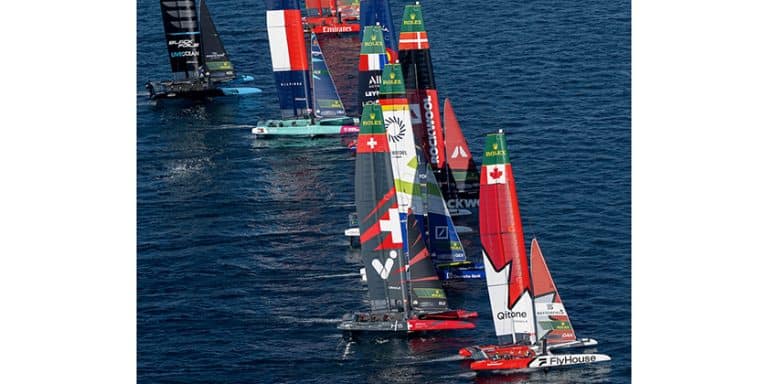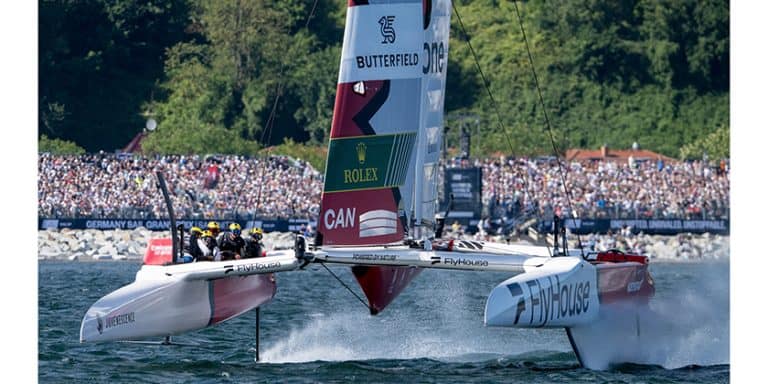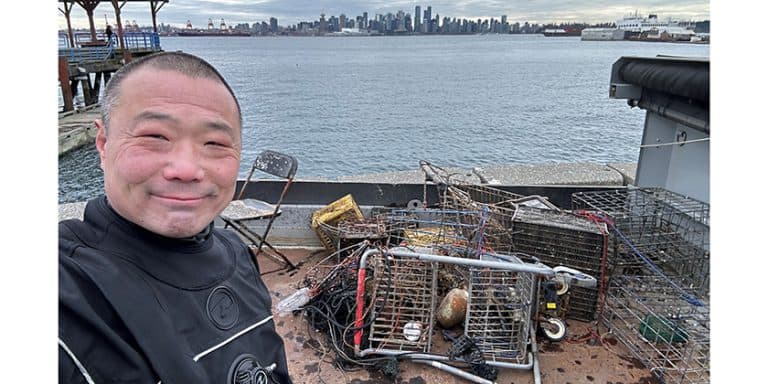A woman’s pathway to high level racing
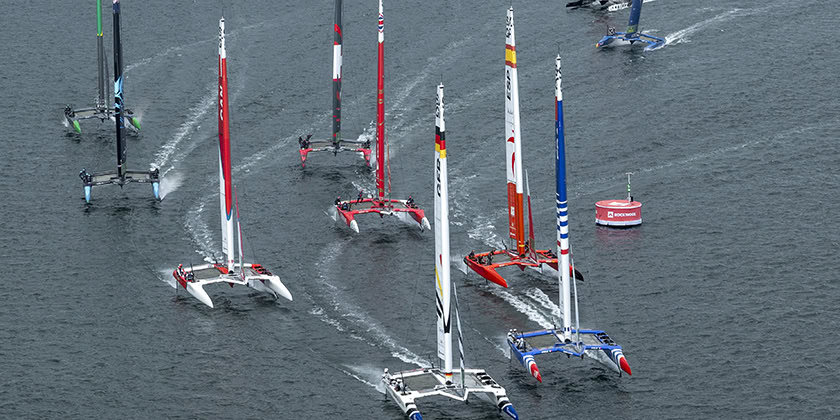
By Katherine Stone
I had the most wonderful opportunity to interview Annie Haeger, at the SailGP Halifax venue. It was especially gratifying for me, as a competitive sailor, mother, teacher and wife to see that pathways have opened up for women to sail at a high, competitive level.
Annie was named ICSA Women’s College Sailor of the Year in 2011 and then went on to be named US Sailing Rolex Sailor of the Year in 2015. She competed at the 2016 Rio Olympics in the 470 Class with her long-time sailing partner Brianna Provancha. She is a six-time national champion.
Annie joined the Canada SailGP Team as the strategist, ahead of the third event of Season 4. It is not a coincidence that SailGP has developed a Women’s Pathway, especially in light of the fact that the 2024 Paris Olympics is the first time there will be parity between male/female athletes.
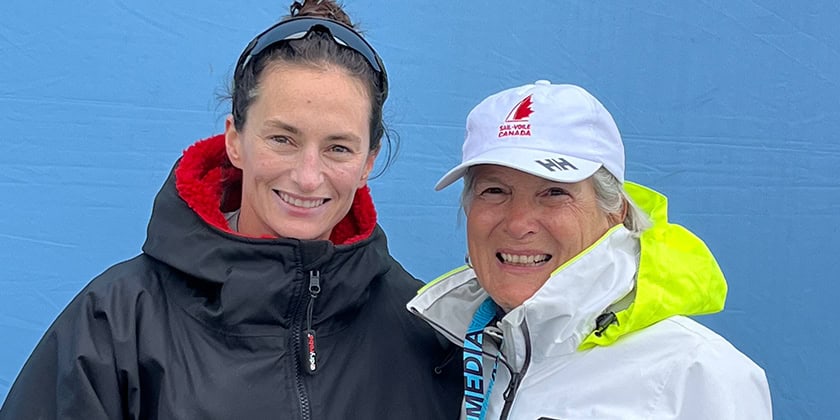
SailGP’s Women’s Pathway
● SailGP introduced the Women’s Pathway in 2021 as part of its Better Sport strategy to accelerate inclusion, inspire change and provide opportunities at the elite level of sailing. It was the first time the teams raced with 6 athletes on board, with every team including a female athlete on the F50 for racing.
● Truly delivering gender equity in professional sailing isn’t a quick fix. It will take time to close the gap in experience and compensate for the historical and societal disadvantages that have prevented women and men from competing together.
● The biggest factor that will help on the road to gender equity is providing more time on the F50. This is where SailGP will prioritize and focus energy, to close the experience gap through delivery of more coaching and training on and off the water for female athletes.
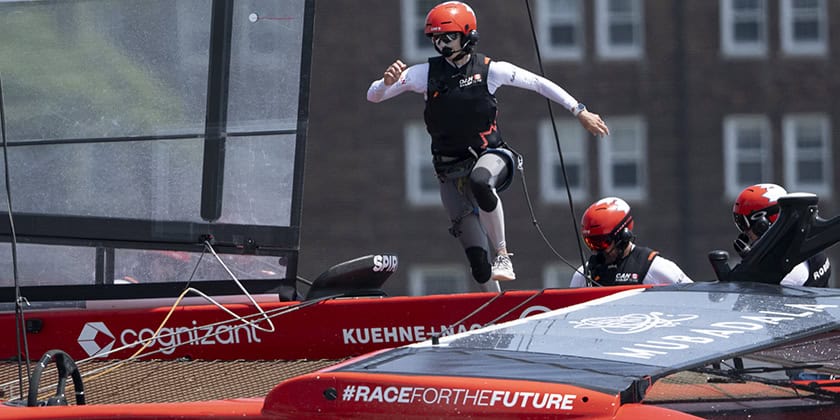
Photo: Ricardo Pinto for SailGP. Handout image supplied by SailGP
Katherine Stone: When did you first start to sail?
Annie Haeger: I was first introduced to sailing at the ripe age of 5, with an Optimist under the Christmas tree – which was immediately followed by tears. I then grew a bit older and began a Learn to Sail program when I was 8 years old at a little lake in Wisconsin called Lake Beulah. Sailing has been in my family for many generations, with my dad and my grandmother growing up in the same Learn to Sail program. Growing up, I sailed Optis, then Lasers, as well as a few regattas in a 420.
Katherine Stone: What enticed you to go to school at Boston College?
Annie Haeger: When I was deciding on which school to go to, I toured around many different college campuses, all of which hosted me for a practice and an overnight stay. One thing that struck me immediately about BC was how engrained the sailing program was with the other athletics. The team atmosphere the coach created for both men and women was competitive but also collaborative with all teammates pushing each other to get better! Greg Wilkinson told me before signing that I could learn how to become a “champion” at the school – which I am happy to say I did end up winning national championships there!
Katherine Stone: How would you compare your Olympic Campaign with the Sail GP campaign?
Annie Haeger: The two campaigns are very different, just starting with the number of people on the team. Working with one other person, you are hyper-aware of how they operate and how to make them perform at their best. While sailing on a team of 6, you can’t focus your individual energy into one person too much and I find when we face adversity, there are many different ways people cope. Another factor that is different from an Olympic campaign is that SailGP is not a program that I am running, meaning I don’t decide when we need training time, when we need to take a break, or when we need to push. It’s fast-paced, chaotic and you have to show up as your best self no matter what is thrown at you!
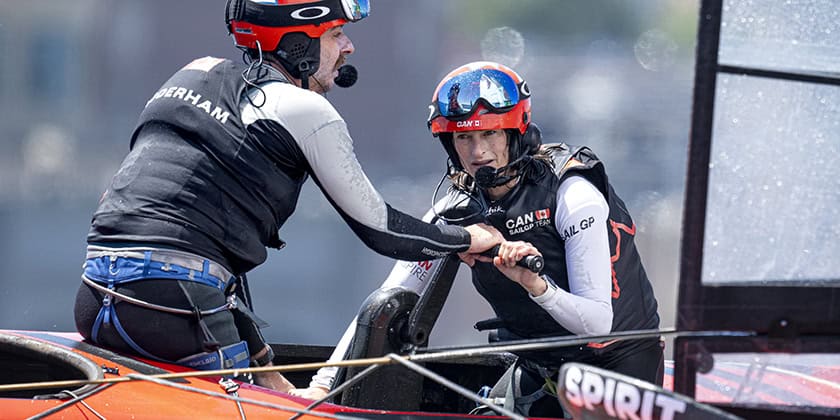
Photo: Ricardo Pinto for SailGP. Handout image supplied by SailGP
Katherine Stone: How was the Halifax venue different than the others?
Annie Haeger: Halifax is an event I will never forget. Sailing in front of home fans was so inspiring and for everyone to be out there, even in the rough weather, made us feel so, so proud to represent Canada. The conditions were very challenging with the squalls that were coming through, making it hard to see the breeze on the water, and the shifty, stiff wind made the wing trimmers and flight controller’s job very challenging.
Katherine Stone: What exactly does a strategist do?
Annie Haeger: The strategist’s role is looking at the big picture conditions on the race course, and trying to provide a helpful context when decision points arise. On the side of the boat, I have written, “Boats, Breeze, Next Move”, to try to simplify in my mind the information I am trying to deliver to Phil. It’s by no means a prescriptive role, meaning I am free to say whatever I think will help us get around the race course faster than the other boats.
Katherine Stone: Do you find it challenging to sail with an all-male crew?
Annie Haeger: I have grown up with two brothers all my life, which I think set me up for success with the all-male crew. I also feel fortunate that everyone has been very accommodating when I joined the team, giving me grace when I asked questions trying to get caught up to the level of where we are operating. They have been a dream to work with.
Katherine Stone: Who are your role models?
Annie Haeger: My role models are Allison Felix and Christine Sinclair. They are both fierce competitors, kind-hearted, and continue to break down barriers for female athletes all over the world. I would also say that Allison’s journey of becoming a mother in sport and how much she shared about that journey, encourages me to be brave and share the hardships of being a professional athlete with young children as well.
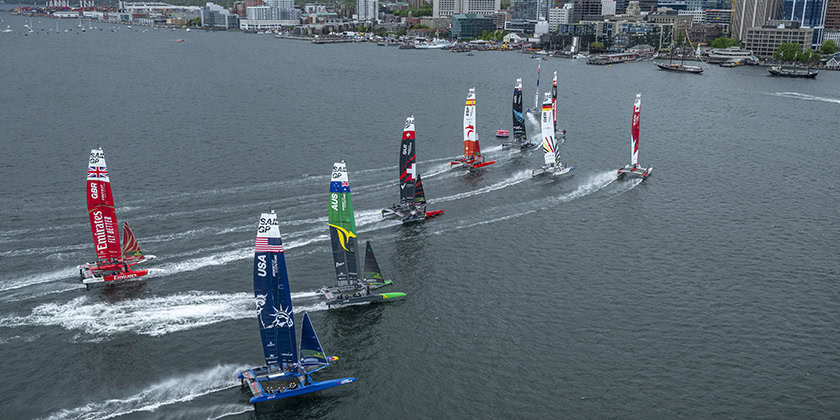
Photo: Ricardo Pinto for SailGP. Handout image supplied by SailGP
Luke and I met at a sailing training camp in Florida, where he was invited to be a training partner for the US team. We were put in a rules-focus group together and the rest is history! He is my partner in crime, and I feel so lucky I found such a great guy.
Katherine Stone: How do you find the balance with being a professional sailor with young children?
Annie Haeger: Balance is extremely challenging, and I can’t say that it has been an easy path. Guilt seems to be something that is intrinsically linked to motherhood and I cannot escape that when I am travelling so much! I think balance for me is to be my best self for my kids. I need to make sure I don’t lose my identity outside of being a mother. Of course, I am first their mom, but I am also an athlete, a businesswoman, and a wife. When I am home, I cherish the time I get to spend with them and when I am gone, I get to think about all the fun adventures we get to experience when I am back. This league also lends itself well to having a family, with short intense trips rather than long slogs having to relocate to another country.
Katherine Stone: Do you see yourself one day skippering a boat like the F50?
Annie Haeger: I would love to drive an F50 – when more pathway programs exist for women in the sport, the sky is the limit for what we can achieve!
Katherine Stone: What are your sailing plans after Sail GP?
Annie Haeger: Honestly just to go as fast as I can. Whether that’s ice boating or wing foiling, I am just having a blast finding the love of the sport through speed.
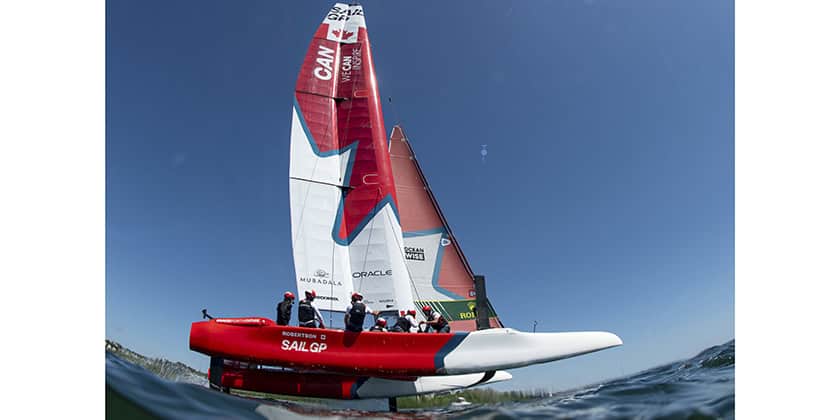
Katherine Stone: I see that you also like to downhill ski? Have your children been out on the slopes yet?
Annie Haeger: Our daughter is a little shredder! We first got her out when she was 2 years-old and she is getting into it – poor kid was born into the wrong family if she wanted to be a couch potato. We plan to get our son on skis this coming winter. Both of them are so fun-loving and adaptable to whatever Luke and I throw their way!
Katherine Stone: What advice would you give to young female sailors who want to aspire to greatness?
Annie Haeger: You never lose – you either learn, or you win. Learn from everyone around you – don’t be afraid to ask questions!



